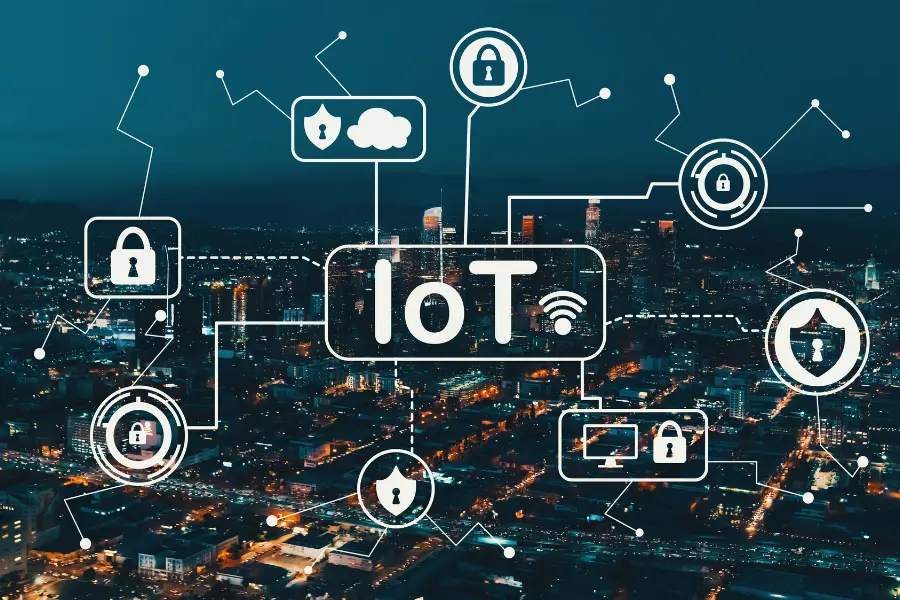Explore how Python powers IoT devices and microcontrollers
The Internet of Things (IoT) is transforming how devices interact, communicate, and function. These devices, from simple sensors to complex systems, rely on programming languages to operate efficiently. Python, known for its simplicity and versatility, has emerged as a powerful tool in the IoT ecosystem. This article explores how Python for IoT Development powers devices and microcontrollers, highlighting its advantages, applications, and the frameworks that make it an ideal choice.

Advantages of Python in IoT
1. Simplicity and Readability of Python for IoT
Python remains the favourite programming language for developers for its simple, easy, and seamless integration capabilities. IOT has been a successful technology against the backdrop of its use of Python tools, used to write and debug code quickly, facilitating rapid prototyping and iteration, as time-to-market is critical in the IOT business.
2. Extensive Libraries and Frameworks
Top Python Libraries for IoT and frameworks like requests and paho-mqtt handle HTTP requests and MQTT protocol. These libraries simplify the interaction between IOT devices and have been a boon for IoT development. Frameworks such as MicroPython and CircuitPython extend functionality to IoT microcontrollers with Python, making it feasible to use Python in resource-constrained environments.
3. Cross-Platform Compatibility
Besides its simplicity and integration capabilities, Python runs all platforms, from full-fledged computers to small microcontrollers. Developers can test and run a code on a computer before deploying it on IOT devices. IoT companies need not wait for the integration of devices to be completed before testing the code.
4. Strong Community Support
Python is an open-source programming language where developers contribute their work for everyone to use free of cost. There are tutorials with proper documentation and third-party modules. If a developer is facing coding issues and needs guidance,(s)he can reach out to the community for help. The community provides updates on the latest advancements in Python and IoT technology free for use by developers.
Python Frameworks and Tools for IoT
1. MicroPython for IoT
MicroPython is a lean and efficient implementation of Python designed to run on microcontrollers and embedded systems. It provides the simplicity of Python while being optimized for performance in environments with limited resources. MicroPython supports various microcontrollers, including the popular ESP8266 and ESP32, making it a go-to choice for IoT projects.
2. CircuitPython
A branch of MicroPython, CircuitPython, developed by Adafruit, focuses on ease of use and education. It simplifies the hardware-software interface, making it accessible for beginners and educators. CircuitPython supports a wide range of sensors and peripherals, allowing developers to quickly integrate hardware components into their IoT projects.
3. Raspberry Pi IoT Applications
While not a microcontroller, the Raspberry Pi is a popular single-board computer that runs a full-fledged operating system and supports Python natively. It is widely used in IoT projects for its versatility, processing power, and ease of integration with sensors and actuators. The GPIO (General Purpose Input/Output) pins on the Raspberry Pi can be controlled using Python libraries such as RPi.GPIO and gpiozero, enabling direct interaction with hardware components.
4. Zerynth for IoT Solutions
Zerynth is a development environment tailored for IoT applications, allowing developers to program microcontrollers using Python. It offers real-time operating system (RTOS) capabilities and supports various hardware platforms. Zerynth is for IoT Device Programming, which simplifies the deployment of IoT solutions by providing tools for IoT with Python device management, over-the-air updates, and cloud integration.
Applications of Python in IoT
1. Python in Home Automation
IoT devices are integral to home automation systems. Smart thermostats, lighting controls, and security systems use Python as the language to communicate, owing to its simplicity and seamless integration features. The devices have platforms created from libraries like openHAB and Home Assistant that are written in Python
2. Industrial IoT with Python
Python is the catalyst for machinery settings in industrial applications. It helps monitor and control machinery, perform predictive maintenance, and perform data analysis. Industrial machinery uses large data sets for interaction, aided by Python's data processing libraries, such as pandas and numpy.
3. Python for Health Monitoring
Modern medicine science has created medical devices that monitor patient health in real-time. Some devices monitor the progress of patients in post-operative care. Python drives health monitoring systems to collect and assess physiological data. Healthcare experts can diagnose and predict health conditions using Python's machine learning libraries, such as sci-kit-learn and TensorFlow that facilitate the development of algorithms.
4. Environmental Monitoring using Python
Modern science and industrialization have destroyed the environmental health of the planet. IoT systems have machinery and equipment to monitor air quality, and weather patterns and predict natural disasters. IoT devices use sensors that run on Python to gather data on air quality, temperature, and humidity. Analysis of such data provides insights for environmental management and research
Conclusion
The growth of IoT has been attributed to the strength of Python's features. It has an extensive ecosystem and simple, versatile features, making it ideal for IoT. Its applications range from home automation to industrial applications, using frameworks like MicroPython and CircuitPython that bring Python's power to microcontrollers. Tools like Zerynth drive advancements in how devices interact and improve our lives.
To know more about how Python enhances IoT Data Collection and Analysis, check out our next resource topic.
Register for the bootcamp from Lejhro and learn programming languages
Active Events
Laying the Groundwork: Python Programming and Data Analytics Fundamentals
Date: Aug 06, 2025 | 7:00 PM(IST)
7:00 PM(IST) - 8:00 PM(IST)
2811 people have registered
Navigating the World of SERP Features: Tips, Tricks, and Strategies
Date: Aug 07, 2025 | 7:00 PM(IST)
7:00 PM(IST) - 8:10 PM(IST)
2811 people have registered
Best Tips to Create a Job-Ready Data Science Portfolio
Date: Aug 06, 2025 | 7:00 PM(IST)
7:00 PM(IST) - 8:10 PM(IST)
2811 people have registered
Bootcamps
Data Science Bootcamp
- Duration:8 weeks
- Start Date:October 5, 2024
Full Stack Software Development Bootcamp
- Duration:8 weeks
- Start Date:October 5, 2024
